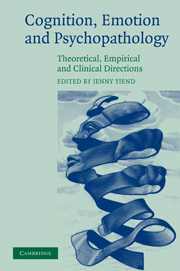Book contents
- Frontmatter
- Contents
- List of contributors
- An introduction and synthesis
- Andrew Mathews: a brief history of a clinical scientist
- Part I Theoretical approaches
- Part II Empirical directions
- Part III Clinical perspectives
- 10 Maintenance mechanisms in social anxiety: an integration of cognitive biases and emotional processing theory
- 11 Mental imagery and social phobia
- 12 Experimental cognitive psychology and clinical practice: autobiographical memory as a paradigm case
- 13 Mindfulness-based cognitive therapy
- 14 Clinical difficulties to revisit
- Index
14 - Clinical difficulties to revisit
Published online by Cambridge University Press: 23 November 2009
- Frontmatter
- Contents
- List of contributors
- An introduction and synthesis
- Andrew Mathews: a brief history of a clinical scientist
- Part I Theoretical approaches
- Part II Empirical directions
- Part III Clinical perspectives
- 10 Maintenance mechanisms in social anxiety: an integration of cognitive biases and emotional processing theory
- 11 Mental imagery and social phobia
- 12 Experimental cognitive psychology and clinical practice: autobiographical memory as a paradigm case
- 13 Mindfulness-based cognitive therapy
- 14 Clinical difficulties to revisit
- Index
Summary
When helping people with complex problems to take a constructive hold on their lives, it sometimes helps if you can fit things together. When analysing biases in emotional processing, it is important to pay close attention to fine detail. Both activities contribute to the development of a science, and the detailed work led and inspired by Andrew Mathews has played a significant part in bringing them closer together. We now know that experimentally established processing biases play a causal role in mediating vulnerability to anxiety, and that selectively manipulating the interpretive bias can modify anxious responses to stress (Mathews & MacLeod, 2002; MacLeod et al., this volume; Yiend & Mackintosh, this volume). Clinicians often behave as if they understand cause and effect. Discovering how it really works, even on a small scale, is of enormous clinical, as well as academic value. It is also the product of Andrew's open-minded curiosity, enthusiasm and ability to keep worrying away at unsolved problems without letting preconceptions intrude, which I valued as a Ph.D. student – and still value as a clinician working in a field in which science and practice are supposedly closely related.
Starting-points
For cognitive therapists, the work on anxiety disorders provides the paradigm example of a successful research and development strategy. It has produced the evidence for the evidence-based practice that providers supposedly offer. As a direct result, we now have working models to guide the treatment of panic disorder, social phobia, obsessive-compulsive disorder (OCD), health anxiety and post-traumatic stress disorder (PTSD) (Clark, 1999).
- Type
- Chapter
- Information
- Cognition, Emotion and PsychopathologyTheoretical, Empirical and Clinical Directions, pp. 290 - 307Publisher: Cambridge University PressPrint publication year: 2004
- 1
- Cited by

